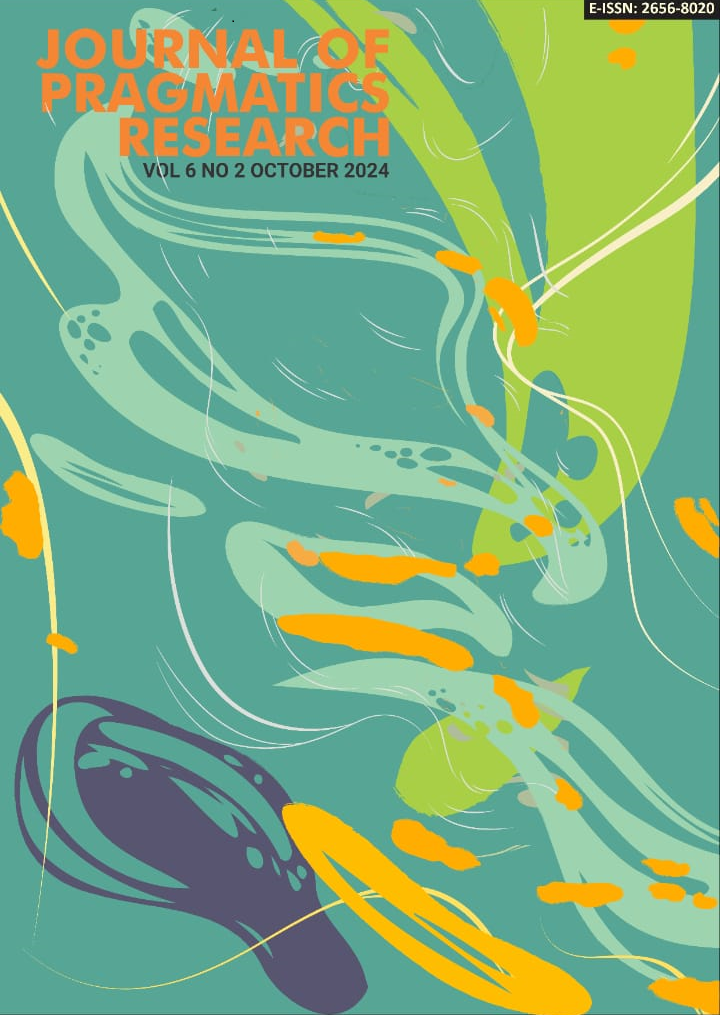Pragmatic Functions of Discourse Particles in Lutsotso conversations
DOI:
https://doi.org/10.18326/jopr.v6i2.186-205Keywords:
Context, conversation, discourse particles, LutsotsoAbstract
The study of the functions of discourse particles in the African languages has received much attention from various scholars, although not from a pragmatic perspective. A good understanding of the pragmatic functions of discourse particles in African languages can benefit language users. However, limited knowledge in this field has affected communication of ideas more clearly and concisely. This paper explores the pragmatic functions of these discourse particles in Lutsotso conversations within the Relevance Theory (RT) structure by Sperber and Wilson (1995). A combined method of native speakers’ intuition and data extraction from Lutsotso conversations were used to collect data. After that, a descriptive research design was used to analyze the collected data. The findings revealed that in Lutsotso conversations, discourse particles play the following pragmatic functions depending on the context: cutting in politely, initiating a new topic, highlighting of a hypothesis that immediately follows, capturing the attention of the listeners, holding the flow and keeping one’s turn, and disagreeing politely.
References
Alami, M. (2015). Pragmatic functions of discourse markers: A review of related literature. International Journal on Studies in English Language and Literature, 3(3), 1- 10.
Anindya, A.H.A. (2014). Conversational interruption in Ophrah Winfrey show Smith and Family interview episode. Undergraduate Thesis, Syarif Hidayatullah State Islamic University, Jarkarta
Brown, P. (2015).Politeness and Language. In International Encyclopedia of the Social & Behavioural Sciences: Second Edition (pp. 326-330) Elsevier Inc. https://doi.org/10.1016/B978-0-08-097086-8.53072-4
Charmaz, K. (2006). Constructing grounded theory: A practical guide through qualitative analysis. Sage.
Collie, J. (2024). Literature in the Language Classroom. International Journal on Verbal Referents (IJVR); vol.86, Issue, 2,184-195.https://doi.org/10.1016/j.beproc.2010.11.
Cook, G. (1983). Discourse. Oxford University Press.
Cutting, J. (2002). Pragmatics and Discourse: A resource book for students. Routledge.
Diewald, G. (2011). Pragmaticalization(defined) as Grammaticalization of Discourse Functions.Linguistics, vol.49, no.2.2011, pp.365-390.https://doi.org/10.1515/ling.2011.011.
Ebarb, K. J., & Marlo, M. R. (2015). Vowel length (in) sensitivity in Luyia morphophonology. Southern African Linguistics and Applied Language Studies, 33(3), 373-390. https://doi.org/10.2989/16073614.2015.1108772
Eberhard C. (2020). Ethnologies: Languages of the World (23rd ed). SIL International.
https://www.ethnologue.com/guides/ most-spoken-languages
Fukada, A., & Asato,N.(2004). Universal politeness theory: application to the use of Japanese honorifics. Journal of Pragmatics, 36(11), 1991-2002.
Fraser, B. (1996). Pragmatic markers. Pragmatics, 6 (2), 167–190. https://doi.org/https://doi.org/10.1075/prag.6.2.03fra
Hansen, M.-B. M. (1997). Alors and donc in spoken French: A reanalysis. Journal of Pragmatics, 28(2), 153–287. https://doi.org/https://doi.org/10.1016/S0378-2166(96)00086-0
Kato, F. (2000). Discourse Approach to Turn-Taking from the Perspective of Tone Choice between Speakers. Dissertation at University of Birmingham.
Leech, G. (2003). Towards An Anatomy of Politeness in Communication. International Journal of Pragmatics; 14:101-123
Makuto et al (2014). Forms and Functions of Relationships: Use of Discourse Markers in Kabras Conversations. IJTEAs
Makuto, M.V. (2009). Forms and Functions of Discourse Markers in Conversations Among Speakers of Kabras. Kenyatta University.
Marlo, R. (2011). Verb Tone in Bantu Languages: micro-typological patterns and research methods. Africana Linguistica XIX. 137-234
Mudogo, B. A. (2017). Word Level Strategies Used to Attain Functional Lukabras Equivalence In The Translation of Mulembe FM Luhyia Newscasts. Unpublished PhD Thesis Maseno University.
Rashid-Bachi, S. & Alhassan, I. (2022). A Pragmatic Analysis of Dagbani Discourse Markers. Open journal of modern Linguistics, 12,148- 157. https://doi.org/10.4236/ojml.2022.122012.
Sasala, J. M., Mudogo, B., & Barasa, D. (2024). Image Schemas in Metaphors of the COVID-19 Pandemic in Lukabaras. Journal of Linguistics and Language in Education, 17(1), 57-73.
Schourup, L. (1999). Discourse markers. Lingua, 107(3-4), 227-265. https://doi.org/10.1016/S0024-3841(96)90026-1
Schroup, L. (1983). Common Discourse Particle in English Conversation https://doi.org/10.1080/14623940802475847
Schourup, L. (1985). Common discourse particles in English conversation. Garland.
Song, Y. L. (2016). A Comparative Study on Discourse Interruption from the Perspective of Intersexual Power. Foreign Language Research, 189(2), 77-82
Sperber, D. and Wilson, D. (2012). Meaning and Relevance. Cambridge University press Tegan (2023). Research Methodology. IJTEA. https://www.scribber.com
Downloads
Published
How to Cite
Issue
Section
License
Copyright (c) 2024 Joel Ongolo, Benard Mudogo, David Barasa

This work is licensed under a Creative Commons Attribution-ShareAlike 4.0 International License.
License and Copyright Agreement
In submitting the manuscript to the journal, the authors certify that:
- They are authorized by their co-authors to enter into these arrangements.
- The work described has not been formally published before, except in the form of an abstract or as part of a published lecture, review, thesis, or overlay journal.
- That it is not under consideration for publication elsewhere,
- That its publication has been approved by all the author(s) and by the responsible authorities – tacitly or explicitly – of the institutes where the work has been carried out.
- They secure the right to reproduce any material that has already been published or copyrighted elsewhere.
- They agree to the following license and copyright agreement.
Copyright
Authors who publish with JOURNAL OF PRAGMATICS RESEARCH agree to the following terms:
- Authors retain copyright and grant the journal right of first publication with the work simultaneously licensed under a Creative Commons Attribution License (CC BY-SA 4.0) that allows others to share the work with an acknowledgment of the work's authorship and initial publication in this journal.
- Authors are able to enter into separate, additional contractual arrangements for the non-exclusive distribution of the journal's published version of the work (e.g., post it to an institutional repository or publish it in a book), with an acknowledgment of its initial publication in this journal.
- Authors are permitted and encouraged to post their work online (e.g., in institutional repositories or on their website) prior to and during the submission process, as it can lead to productive exchanges, as well as earlier and greater citation of published work.






